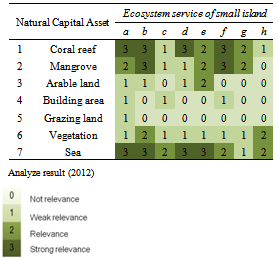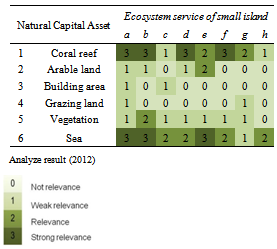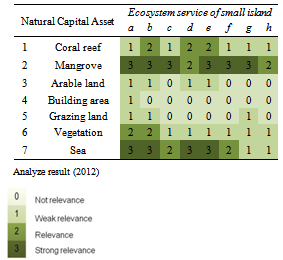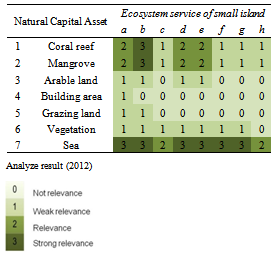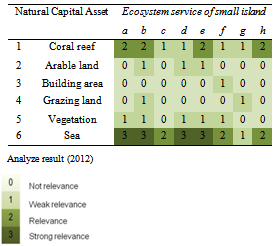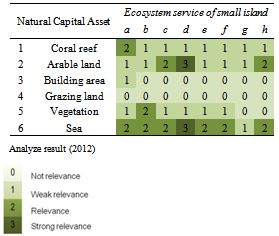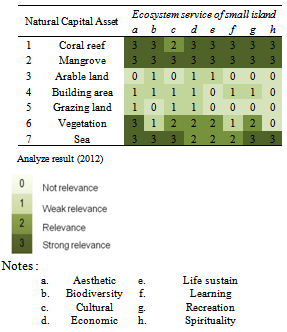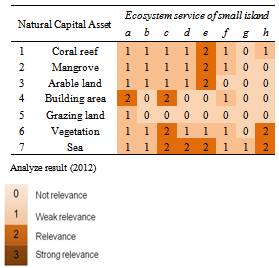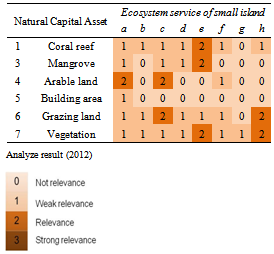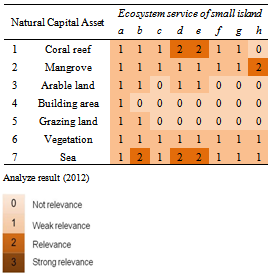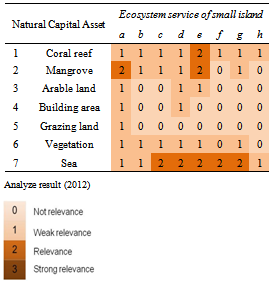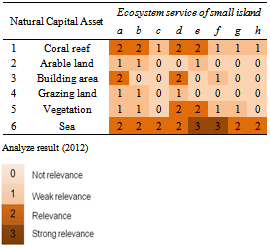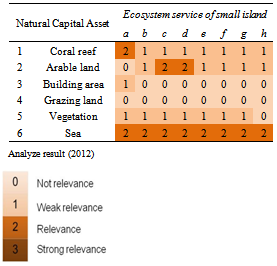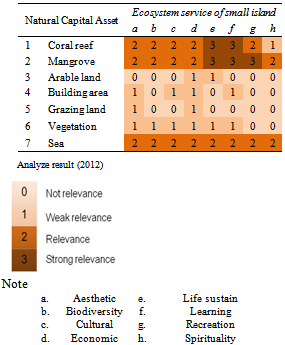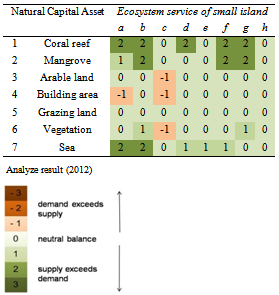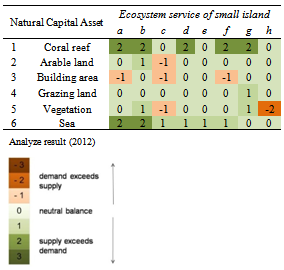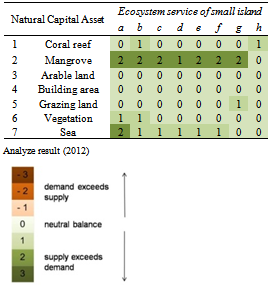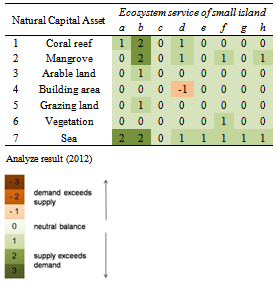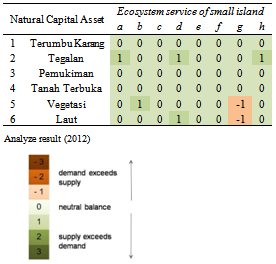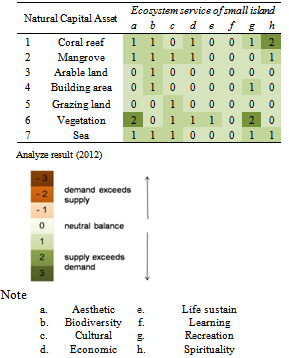-
Paper Information
- Paper Submission
-
Journal Information
- About This Journal
- Editorial Board
- Current Issue
- Archive
- Author Guidelines
- Contact Us
International Journal of Ecosystem
p-ISSN: 2165-8889 e-ISSN: 2165-8919
2013; 3(5): 106-114
doi:10.5923/j.ije.20130305.02
Socio Ecological System (SES) Assessment for Tourism at Sapeken Archipelago, Sumenep, Indonesia
Agus Romadhon1, Fredinan Yulianda2, Dietriech G Bengen2, Luky Adrianto2
1Department of Marine and Science, Trunojoyo University, Kampus Unijoyo, Telang, PO. BOX 2 Kamal Bangkalan
2Faculty of Marine Science and Fisheries, Bogor Agricultural University
Correspondence to: Agus Romadhon, Department of Marine and Science, Trunojoyo University, Kampus Unijoyo, Telang, PO. BOX 2 Kamal Bangkalan.
| Email: |  |
Copyright © 2012 Scientific & Academic Publishing. All Rights Reserved.
Tourism, has been observed as a complex ecology, social and economic phenomenon, which also been considered to unprecedented levels of development and prosperity worldwide. This study is aimed to analyse the social-ecological system of tourism in a small island entity using Sapeken Islands of Madura as a case study. We use an socio-ecological system (SES) approach suggested by Burkhard et al (2012) which consists of three Likert Scale-Matrix : 1) capacity of ecosystem services (supply), 2) request ecosystem services (demand), and 3) balance status (budgets) of the ecosystem services. The results are: 1) the largest usage of ecosystem service’s demand by communities at Sapeken archipelago is the sea, with the exception for Sepanjang Island where the largest is mangrove’s cover, 2) planning of tourism activities (ecotourism) in Sapeken archipelago by looking at balance status (budgets) ecosystem services, it is possible to do. Conditions of some natural capital assets are still able to provide a number of ecosystem services that can be used as the attraction of tourism.
Keywords: Sapeken Archipelago, Socio-ecological System, Capacity of Ecosystem Services, Request of Ecosystem Services, Balance Status of Ecosystem Services
Cite this paper: Agus Romadhon, Fredinan Yulianda, Dietriech G Bengen, Luky Adrianto, Socio Ecological System (SES) Assessment for Tourism at Sapeken Archipelago, Sumenep, Indonesia, International Journal of Ecosystem, Vol. 3 No. 5, 2013, pp. 106-114. doi: 10.5923/j.ije.20130305.02.
Article Outline
1. Introduction
- Sapeken archipelago is a 201,887 km2 area formed by a series of small islands located in 6° 46’ - 7° 06’ S dan 115° 10’ - 115° 44’ E. Sapeken archipelago has around 36 genera of corals (FDC-INNR, 2006), 36 species of mangrove (Suharjono and Rugayah, 2007), white sandy beaches and diversity of the local culture. These conditions make Sapeken archipelago has competitive advantages as well as the potential to increase the economic bargaining power and sustainable development of the islands.As small island, Sapeken archipelago has some limitation, such as smallness (size), limited resources, scare of water, insufficient productivity, competences and infrastructure, geographic isolation, and ecological fragility lead to their vulnerability (Howarth, 2002). This vulnerability, together with their exposure to natural catastrophes (Roper, 2005) turn islands into particularly interesting cases to be studied; especially when intense tourism activity makes it more and more difficult for islands to obtain a sustainable character (Frangialli, 2006)Taking into account the development efforts of small islands in a sustainable manner, Robertico (2004); Bengen and Retraubun (2006), state that the strategy needs to be done is in the form of sustainable tourism activities (sustainable tourism). For Sapeken archipelago the highly applicable sustainable tourism strategy is an effort to protect the existing potential. Tourism activities are a complex process in which there is interaction between tourists, people and resources (Farrell and Twining-Ward, 2004). One of the possible impacts of tourism activities as resources use activity at Sapeken archipelago ecosystems is changes in land use and land cover as natural capital assets. Furthermore, like any resource use activity, tourism risks becoming unsustainable if local ecological and socio - cultural capacities are not respected (Wall, 1997). Conversely, properly planned and implemented tourism can contribute towards conservation and sustainable use of marine and terrestrial resources at the host destination (White and Rosales, 2001).Such interactions can be better understood in the context of complex adaptive socio-ecological system approach, where there are strong interactions between ecosystems and society (Gunderson and Holling, 2002).In accordance to sustainable tourism strategies, the understanding of ecology, economy and social condition of the islands through SES (socio ecological system) is needed as a preliminary assessment of the Sapeken archipelago’s potential for the development of tourism activities.
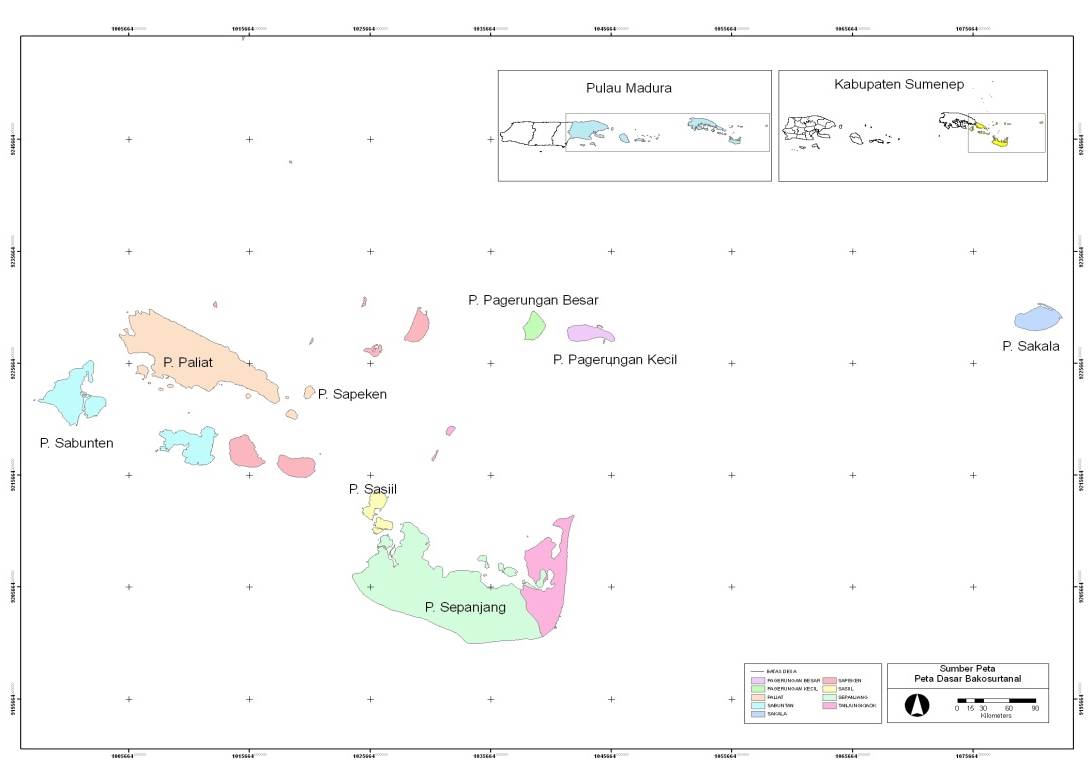 | Figure 1. Map of study area at Sapeken Archipelago |
2. Methodology
- This research was conducted on March – June 2011 at Sapeken archipelago (Fig 1). Data collection for SES assessment includes: 1) secondary data from literatures and related reports; 2) primary data that were obtained through interview using a set of questionnaire. The SES method as a new qualitative approach referring to Burkhard et al (2012) was used to map the ecosystem services. SES consists of three assessment stages, i.e: 1) ecosystem service capacity (supply); 2) ecosystem service’s demand and 3) ecosystem service’s equilibrium (budget). Likert scale is used for grading scale.a. Ecosystem Capacity AssesmentThe ecosystems capacity assessment has been conducted by giving value or relevance score to the ability of the small island, represented with land cover in providing ecosystem services. The matrix is used as follows:
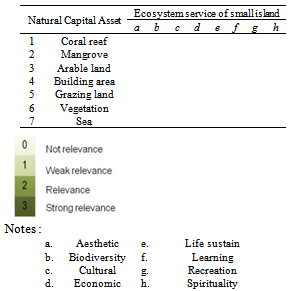 b. Ecosystem Demand Assessment Assessment request (demand) of ecosystem services is done by giving value the request of human or relevance score for ecosystem services in certain types of land cover. The matrix used is as follows:
b. Ecosystem Demand Assessment Assessment request (demand) of ecosystem services is done by giving value the request of human or relevance score for ecosystem services in certain types of land cover. The matrix used is as follows: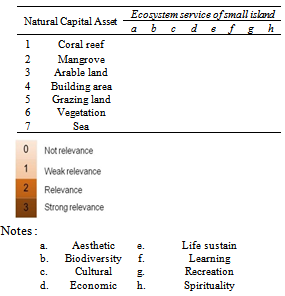 c. Ecosystem Service’s EquilibriumAssessment of the ecosystem services equilibrium status, is obtained by subtracting the value or score on the matrix ecosystem capacity (supply) with the matrix request (demand) services ecosystem. The scale ranges from - 3 to 3. Sign (-) indicates a request (demand) exceeds supply (supply); 0 = neutral balance, and to sign (+) indicates the supply exceeds demand. The matrix used is as follows:
c. Ecosystem Service’s EquilibriumAssessment of the ecosystem services equilibrium status, is obtained by subtracting the value or score on the matrix ecosystem capacity (supply) with the matrix request (demand) services ecosystem. The scale ranges from - 3 to 3. Sign (-) indicates a request (demand) exceeds supply (supply); 0 = neutral balance, and to sign (+) indicates the supply exceeds demand. The matrix used is as follows: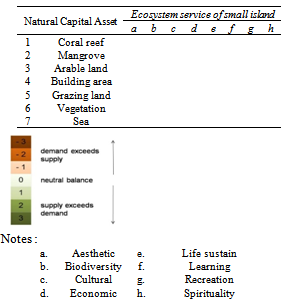
3. Results and Discussion
- Results of analysis socio-ecological system (SES) related to development of tourism activities in Sapeken archipelago area as follows:
|
3.1. Assessment of Ecosystem Service Capacity
- The ecosystems capacity to provide ecosystem services can be used for various needs strongly associated with (a) natural conditions, such as natural land cover (vegetation), hydrology, soils, fauna, elevation, slope and climate, and (b) the human impact, especially land use emissions, pollution and other (Burkhard et al., 2012). Assessment of ecosystem service capacity result are presented in Table 1 - 7 below.
|
|
|
|
|
|
3.2. Ecosystem Service’s Demand
|
|
|
|
|
|
|
3.3. Availability Status of Ecosystem Service
- Availability status of ecosystem service (budget) is measured by comparing ecosystem capacity (supply) and ecosystem service demand. The results describe ecosystem service’s equality dynamic in Sapeken archipelago. The availability status of ecosystem service at Sapeken archipelago is explained in the following results.
|
|
|
|
|
|
|
4. Conclusions
- Based on results and discussions that has been described, the conclusions are as follows:1. Condition of socio-ecological system at Sapeken archipelago through the availability status (budget) of ecosystem services showed different results on capacity (supply) and demand for ecosystem services (demand). The highest availability status (budget) ecosystem services is at Sepanjang island and the lowest is at Sapeken island. The higher value of the availability status (budget) shows natural capital of ecosystem services such as coral reefs, mangroves, arable land, building area, grazing land, vegetation and sea is sparse and well maintained so it can still provide services and goods in the form of aesthetics, biodiversity, culture, economy, sustainability, learning, recreation and spiritual life of the community at Sapeken archipelago.2. Availability status of ecosystem services (budget) has been linked to ecosystems utilization by community. It is seen from differences characteristics of community activity to manage the resources in each small island, be adapted to availability of ecosystem services (budget) in Sapeken archipelago.3. Related to the planning of ecotourism activities (ecotourism) in Sapeken archipelago by looking at the of availability status of ecosystem services (budgets), it is possible to be developed. Conditions of some natural capital assets that is still able to provide a number of ecosystem services that can be used as an tourism attraction.Lastly, assessment of socio-ecological system (SES) should be integrated in the planning of tourism activities, in order to provide existing condition in-depth overview related to ecosystem status as well as well as to support the existing social status.
ACKNOWLEDGEMENTS
- We gratefully acknowledge the anonymous reviewers.
 Abstract
Abstract Reference
Reference Full-Text PDF
Full-Text PDF Full-text HTML
Full-text HTML